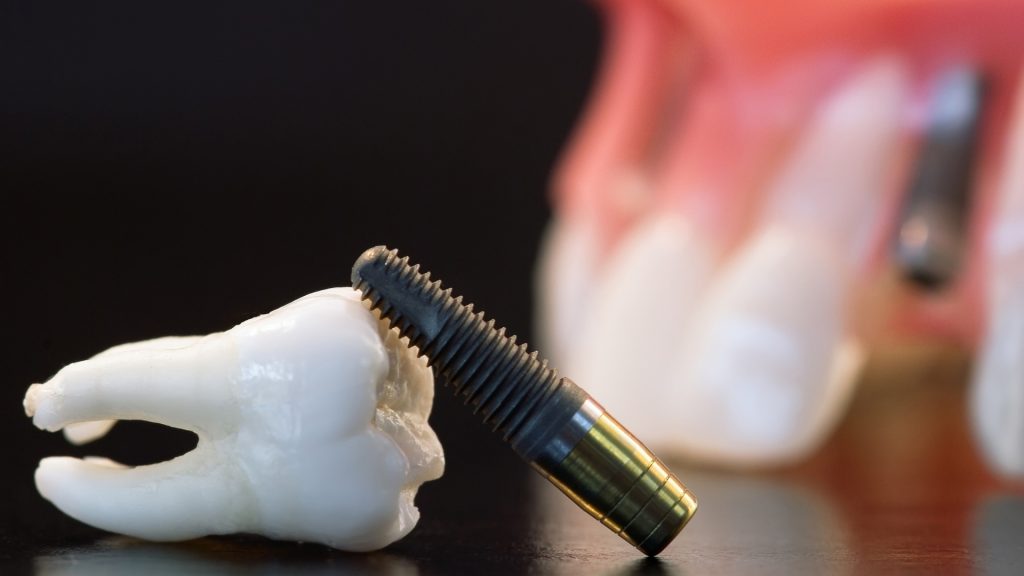Unfortunately, in some situations, it is impossible to avoid tooth loss. Despite every effort to save it, an injury or an extensively decayed tooth can compromise your overall dental health and lead to more serious issues down the road.
If you need to undergo a tooth extraction in Ottawa, our team at Rockcliffe Dental & Denture Centre can help you determine whether a socket preservation bone graft procedure is necessary at the time of extraction.
Keep reading this article to learn more about how socket bone grafting can help you prepare for dental implant therapy and aid in restoring the beauty and functionality of your smile.
What is Tooth Socket Preservation Bone Graft?
A socket preservation graft, also known as “alveolar ridge preservation graft”, is a surgical procedure used to fill in a socket after tooth extraction. At the time of tooth removal, a dental surgeon will place special bone grafting material in the extraction socket to avoid post-extraction bone loss and accommodate future replacement tooth options like dental implants or dental bridges.
Types of bone graft materials and socket preservation techniques include:
- Allografts. With allografts, donor tissue is taken from other humans; it can be obtained from a licensed bone and tissue bank
- Autografts. With autografts, the grafting material is taken directly from the patient’s own body, usually another part of the jawbone or the chin.
- Xenografts. Xenografts are derived from an animal source (most commonly, a cow) and are also purchased from a bone and tissue bank.
Placing an extraction socket preservation graft at the time of tooth extraction doesn’t require a separate surgery and doesn’t cause any additional discomfort, as there is already exposed bone post – extraction.
Is Bone Graft Necessary after Tooth Extraction?
No, socket preservation bone grafts aren’t necessarily required every time a tooth is extracted, – this depends on the patient’s age, biotype, the location of the extracted tooth, and the overall oral health of the patient. In some cases, extraction sites can heal completely fine on their own, resulting in sufficient bony ridge height and horizontal ridge width for implant placement.
However, with complicated extractions, a lot of alveolar bone can be lost, and adding a bone graft at the time of removal can prevent the socket walls from caving in, providing a solid, firm foundation for the future dental implant.
Benefits of Socket Preservation Grafting
Socket grafting is often used if the patient decides to proceed with restorative procedures which not only include dental implants but also dental bridges and dentures.
- Implants. A dental implant candidate must have a minimum amount of jaw bone to surround the implant in order to establish long-term stability and success. Without adequate bone volume, the patient may experience accelerated bone and soft tissue loss around the implant over time. A socket preservation graft is used to ensure that you will have enough bone to enjoy your dental implants for a lifetime.
- Dental bridges. A graft after a tooth extraction will help to preserve proper bone height to prevent bone loss and lowering gum tissue levels. Without a socket preservation graft, you are likely to see a growing space between an opposing bridge and recessed gum. To improve the aesthetics of the future dental bridge, the bone grafting material will be applied at the time of extraction.
- Dentures. Most dentists choose not to conduct ridge preservation procedures and extraction site reconstruction before denture therapy. However, the stability, fit, and retention of dentures are improved with a higher quantity of jawbone. As such, your dentist may recommend placing socket preservation grafts in strategic areas after extractions.
- No post-extraction tooth replacement. Even if patients choose not to replace the lost tooth, an alveolar ridge preservation graft can still have its benefits. Gum recession following alveolar ridge resorption at the extraction site could expose roots of the neighboring teeth, leading to increased sensitivity.
How to Restore the Bone Ridge After Atrophy
Patients that have been missing a tooth for an extended period of time often experience a certain degree of bone loss and deterioration. The good news is that the issue can be addressed, even though the process will be more extensive as compared to a socket preservation procedure.
Ridge Augmentation Procedure
If the bone loss and atrophy were experienced over time, a ridge augmentation procedure can be performed. This treatment is conducted to add width, height, and volume to the jaw.
Importantly, with a socket graft, the graft material is placed directly into a socket, receiving nutrition and blood supply from surrounding socket walls. However, if the graft is performed after the socket healing is complete, additional material will be placed next to the already-healed jawbone. Not only this requires a separate surgical procedure and re-opening of the gums, but also this “guided tissue regeneration” process is less predictable, as the graft needs to heal with nutrition and blood supply coming only from one of its sides.
Sinus Lift Surgery
If bone ridge has collapsed in the posterior portion of the upper jaw, the sinuses could drop down and take up space that used to be occupied by now missing teeth. To address this issue, a maxillary sinus lift surgery can be performed. After carefully “lifting” the sinus membrane, bone graft material is placed underneath to promote bone regeneration.
Socket Grafting Procedure Aftercare
The bone graft consists of numerous components and small particles placed carefully inside the socket. However, the wound can be easily disturbed, leading to the particles coming out. If you notice a slight loss of bone graft granules, don’t be alarmed – it is completely normal.
 However, you should be proactive and minimize the loss of the graft particles by following these oral care instructions:
However, you should be proactive and minimize the loss of the graft particles by following these oral care instructions:
- Avoid spitting and rinsing for the first 24 hours after the surgical procedure to allow the graft material and the blood clot to stabilize.
- Do not disturb or touch the wound.
- Do not touch the grafted area with your tongue or fingers. The bone graft material is easy to move during the first several days of the socket healing process.
- Do not smoke.
- If a front tooth has been removed, do not lift up or pull on the lip to see the sutures. This movement can potentially tear the sutures and damage the wound site.
- After the first 24 hours, you can cleanse the mouth with a gentle saltwater rinse, but be careful to avoid vigorous rinsing.
As the tooth extraction site heals, you will be invited to come back to your dental clinic in Ottawa several times for follow-up appointments, where your dental implant surgeon will ensure that your extraction site is healing properly. In most cases, you will need to allow for a healing time of 3 to 6 months before implants can be placed to replace natural teeth.
Tooth Extraction and Bone Graft Cost
The cost of socket preservation grafting can vary depending on the amount of bone grafting material required and the type of graft chosen. The overall cost usually ranges between $579 and $1,183.
Learn More about Alveolar Ridge Preservation Graft in Ottawa
Tooth extraction and subsequent socket bone grafting procedures don’t need to be stressful. In the hands of careful and skilled implant dentists at Rockcliffe Dental & Denture Centre, you can be sure to receive predictable treatment outcomes and restore the aesthetics and functionality of your smile.
Contact us today to learn more about how bone grafting can preserve your jawbone and improve overall oral health.
- Learn more about dental bone grafting in Ottawa
- Learn more about dental bone graft recovery & aftercare

